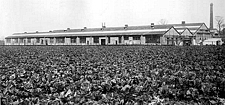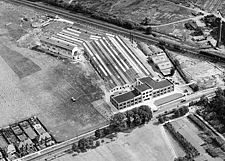|
|
|
Introduction
The Southend-on-Sea works of EKCO was only engaged for a brief period in lamp manufacturing. The company's roots were not in lighting but it diversified into this area shortly after beginning manufacture of electronic valves, whose production technology is relatively similar to that of lamps. A few years after startup of operations, the company was merged with Ensign Lamps of Preston to form Ekco-Ensign, and it was decided to pool all lampmaking at Preston. The Southend factory quickly gave up lampmaking, but continued for many years more in the production of other electrical and plastic goods.
|
 Priory Crescent Factory, 1930
Priory Crescent Factory, 1930
|
| Address |
Priory Crescent, Southend-on-Sea, United Kingdom |
| Location |
51.5570°N, 0.7068°E |
| Opened |
1908 |
| Closed |
1923 |
| Products |
Incandescent Tantalum filament & tungsten filament lamps. |
Company Foundation
The company was founded by Eric Kirkham Cole together with his future wife in 1924, when they began making their own radio sets. At the time the availabe radios were operated by a pair of batteries - one delivering a low voltage to energise the cathodes of the radio valves, and the second providing a high tension output for the main circuitry. HT batteries were expensive and did not last long, and Cole devised a mains powered transformer which became very popular to replace the costly batteries. In 1926 he went into business with Mr. William Verrells, and a private company E.K. Cole Limited was founded. A year later manufacturing began at a small factory in Leigh-on-Sea.
As demand grew, larger premises were required and a large building was constructed at Southend-on-Sea, which became the company's home for the following four decades. Such was the growth in business that Ekco had become a major consumer of electronic valves, and in 1937 the company established its own radio tube production so as to secure better pricing of these critical components. Ekco was only ever a small player in valves and probably could not compete with the major manufacturers - but the loss of sales of those former suppliers must have pushed them to consider offering Ekco better pricing in order to win back their lost business. As a result in 1939, Ekco sold its radio valve division to the major competitor, Mullard Ltd.
|
Lampmaking Operations
The kind of machinery used for the manufacture of valves is essentially the same as that required for electric lamps, and following the closure of the valve business Ekco converted this division of its factory for lampmaking.
During the difficult times of the 1939-45 war, the government-enforced pooling and zoning regulations introduced EKCO to another small lampmaker, Ensign Lamps of Kent Street, Preston. Both companies came to value their co-operation, which was further strengthened during the war years. Shortly after the war it was recognised by both parties that there would be advantages in formalising their agreements, and on 13th March 1947, Ekco merged with the lighting division of Ensign to form Ekco-Ensign Electrical Ltd. This was an ideal solution for both companies because it gave them increased power in the lighting business, and Ekco had meanwhile become more interested in radio production.
The lampmaking was all concentrated at the Kent Street works, and allowed Southend to return to its primary electronic interests. The remaineder of Ekco continued to be run independently and were not involved in the Ekco-Ensign merger, which was to cover only electric lamps. |
Later Southend Activities
Ekco at Southend grew to a vast manufacturing operation, at its peak employing some 8000 staff. The expertise gained from ordinary domestic radio and television production put it in a strong position among British electronic manufacturers, and in particular during the war Ekco played a major role in the production of military equipment. Ekco was recognised as being the best manufacturer of shortwave radios, and it was to this company that the UK government turned when commissioning apparatus intended for intercepting German communications. Subsequently a number of Ekco engineers were dispersed to shadow factories around the country since the Southend works was at acute risk of being targetted for boming, and at these satellite locations the company produced important components of the first Radar systems. In postwar times Ekco's electronics excellence was further tested in the development of the control systems for some of the country's first nuclear power plants.
Aside from much of the secretive electronics work, Ekco also made itself a household name. During the fifties and sixties millions of households stared every night at television sets embossed with the Ekco logo, and the company became particularly strong in electrical heating appliances. During the 1930s it also pioneered the production of bakelite housings for its radios and electrical goods at a time when other manufacturers still employed wood, and at one time owned the largest injection moulding press in the country. The Ekco plasticware division became particularly successful once it diversified from making housings for its electrical apparatus to the manufacture of all kinds of domestic plasticware. Product design was rated particularly highly, both visually as well as functionally, for instance with the invention of the first stackable sets of domestic tableware. The company expanded quickly around the country with factories in Malmesbury, Aylesbury, Woking, Preston, and Rutherglen - and later internationally with operations stretching from Colombia to New Zealand.
In 1960 Ekco merged with Pye Electronics to form British Electrical Industries Ltd, and from this time onwards its fortunes began to decline. Following the death of Eric Cole in 1965 the company began to lose focus, and was hit hard again in 1966 following Pye's involvement in a major financial scandal, and the resulting closure of the Soutend factory that same year. The group was taken over by Philips Electronics in 1967 and by 1970 what was once a household name had practically disappeared. For a number of years part of the factory site was occupied by other small tenants, until its demolition in 2008.
|
|
 |
|
 |
|
 |
|
 |
|
| Factory 1930 |
|
Extended Factory c.1940 |
|
Aerial View 1934 |
|
Aerial View 1970s |
|
|
|
|
|
|